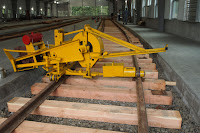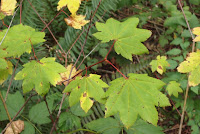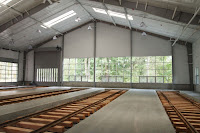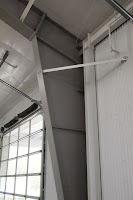 Fall 2010 was an eventful season inside the Museum’s Conservation and Restoration Center. The center of attention has been a first generation diesel-electric locomotive with ties to the local forest industry and the results are spectacular! Funded with a grant from the National Railroad Historical Society, private donors and a Boeing Company matching grant, the project is wrapping up this month.
Fall 2010 was an eventful season inside the Museum’s Conservation and Restoration Center. The center of attention has been a first generation diesel-electric locomotive with ties to the local forest industry and the results are spectacular! Funded with a grant from the National Railroad Historical Society, private donors and a Boeing Company matching grant, the project is wrapping up this month.Earlier this year, the Museum began rehabilitation work in earnest on locomotive 1, a Fairbanks-Morse model H12-44 from Enumclaw’s White River Lumber division of
 Weyerhaeuser. Built in 1951, the locomotive has an opposed piston diesel common in the marine sector, but unique in the railroad industry. When built, the locomotive was remarkable for delivering an incredible 1,200 horsepower with just a six cylinder/twelve piston diesel.
Weyerhaeuser. Built in 1951, the locomotive has an opposed piston diesel common in the marine sector, but unique in the railroad industry. When built, the locomotive was remarkable for delivering an incredible 1,200 horsepower with just a six cylinder/twelve piston diesel.Rehabilitation work has included car body repairs, new piston rings, new electric traction motor brushes, auxiliary generator repairs, surface preparation, new windows as required, and painting. Over 1,800 hours of effort has been invested in the project and the locomotive was moved out of the CRC last week. The lettering has not yet been applied; warmer weather will facilitate that final visual aspect of the project. Some of the work has been highlighted in Museum blog posts here and here.
 Substantial completion of locomotive 1 also leads to a new beginning: chapel car 5 “Messenger of Peace” was moved into the CRC to begin an extensive rehabilitation. Earlier this year, many museum supporters participating in the Partners in Preservation initiative of the National Trust for Historic Preservation and American Express by voting for their favorite project. Those efforts resulted in a $50,000 award in support of chapel car 5. Other support includes the Save America’s Treasures award, the Capital Projects Fund for Washington’s Heritage, 4Culture and individual and corporate donors.
Substantial completion of locomotive 1 also leads to a new beginning: chapel car 5 “Messenger of Peace” was moved into the CRC to begin an extensive rehabilitation. Earlier this year, many museum supporters participating in the Partners in Preservation initiative of the National Trust for Historic Preservation and American Express by voting for their favorite project. Those efforts resulted in a $50,000 award in support of chapel car 5. Other support includes the Save America’s Treasures award, the Capital Projects Fund for Washington’s Heritage, 4Culture and individual and corporate donors. Chapel car 5 is listed on the National Register of Historic Places under National criteria acknowledging it as one of the most historically significant artifacts in the Museum’s collection. Rehabilitation work will include repairs to the car’s frame, especially to deteriorated sections of side sill. Work will also include rehabilitation of the exterior cladding, reconstruction of the interior living quarters, restoration of the sanctuary, and restoration of the end platforms. Project completion is expected in two years.
Chapel car 5 is listed on the National Register of Historic Places under National criteria acknowledging it as one of the most historically significant artifacts in the Museum’s collection. Rehabilitation work will include repairs to the car’s frame, especially to deteriorated sections of side sill. Work will also include rehabilitation of the exterior cladding, reconstruction of the interior living quarters, restoration of the sanctuary, and restoration of the end platforms. Project completion is expected in two years.So the end of one project is the beginning of another.
Photos:
Top - Locomotive 1 on the CRC lead after repainting.
Second - Locomotive 1 and just a few of the dozens of people involved in its rehabilitation. Top, left to right, Allan W., Bob M., Clark Mc., Hugh H., Jon B., Roger S., & Russ S.
Third - Pettibone Speedswing moves the chapel car into the CRC.
Bottom - Project manager Clark Mc. begins assessing chapel car 5 shortly after it arrived in the CRC.
Video - images of the locomotive 1 moving out of the CRC and the chapel car moving in.










































 Weyerhaeuser
Weyerhaeuser




